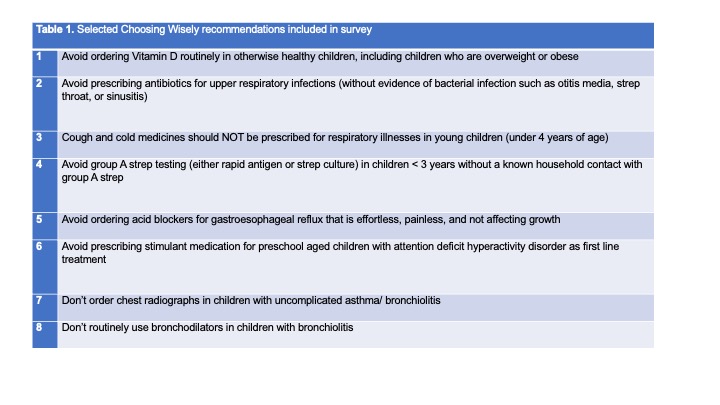General Pediatrics
Session: General Pediatrics 2
238 - Association between Provider Behavior and Awareness and Agreement with Choosing Wisely Recommendations in Primary Care
Friday, May 3, 2024
5:15 PM - 7:15 PM ET
Poster Number: 238
Publication Number: 238.622
Publication Number: 238.622

Elizabeth Wolf, MD, MPH (she/her/hers)
Associate Professor
Virginia Commonwealth University School of Medicine
Richmond, Virginia, United States
Presenting Author(s)
Background: The American Academy of Pediatrics (AAP) and Choosing Wisely have identified several low-value services in primary care that either harm or offer no benefit to children. It is not known how provider awareness and agreement with the recommendations affects ordering behavior.
Objective: To understand how awareness and agreement with AAP and Choosing Wisely recommendations correlates with provider behavior.
Design/Methods: We recruited providers that care for children through the Ambulatory Care Outcomes Research Network (ACORN) and the Virginia AAP listservs and newsletters. The survey contained questions about the awareness of, agreement with, and behavior regarding eight common low-value services in pediatric primary care. Three- (awareness) or five-point (agreement and behavior) Likert scales were used. Responses were dichotomized for analyses. Fisher's exact test was used to explore the relationships between behavior and awareness, as well as behavior and agreement.
Results: We received responses from 114 providers (36.9% family medicine and 48.6% pediatric) practicing in Virginia. Awareness of the recommendations was lowest for group A strep testing under 3 years without a household contact (54.8%) and screening vitamin D levels in otherwise healthy children (56.6%). Awareness was highest for antibiotics for upper respiratory infections (URIs) (95.0%) and cold and cough medications in young children (90.2%). Agreement with the recommendations was lowest for group A strep testing under 3 years (72.6%) and vitamin D screening (87.0%) and highest for chest x-rays for asthma and bronchiolitis (96.2%) and antibiotics for URIs (94.9%). There was a significant association (p < .05) between awareness and ordering of vitamin D screening, antibiotics for URIs, group A strep testing in children under 3 years, stimulant therapy in preschoolers, bronchodilator use for bronchiolitis, and chest x-rays for uncomplicated asthma or bronchiolitis. The associations between awareness and behavior for cold and cough medications and anti-reflux medications in infants were not significant. There was a significant association between agreement and ordering of vitamin D screening. For other services, the association between agreement and behavior was not significant.
Conclusion(s): The awareness of AAP and Choosing Wisely recommendations was highly variable amongst providers and appeared to drive behavior in primary care. To reduce unnecessary and potentially harmful care to children, additional education and outreach to primary care providers is needed.

.png)
